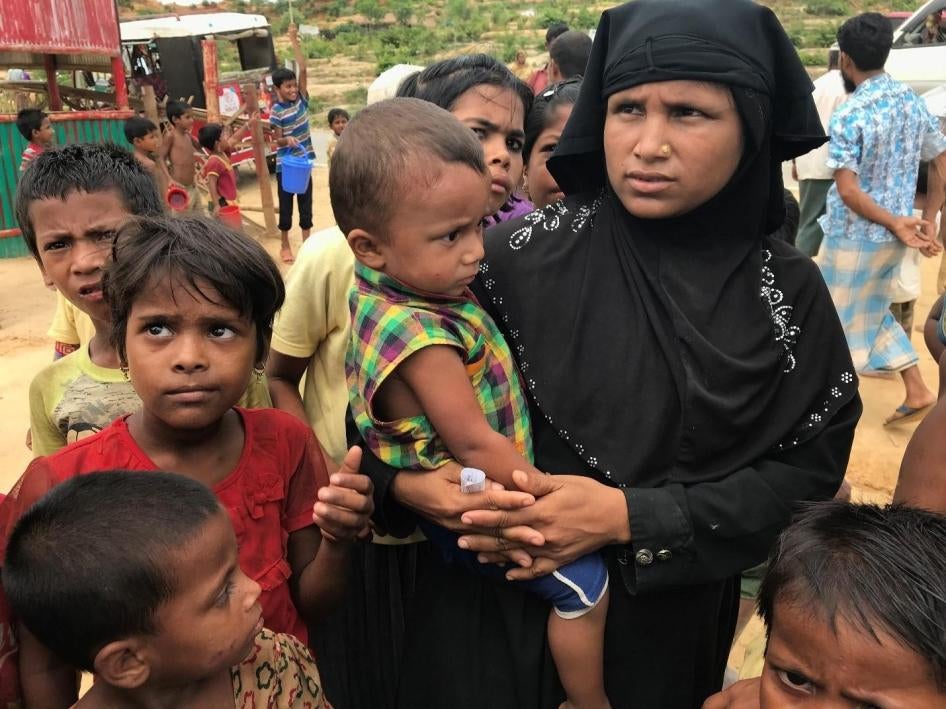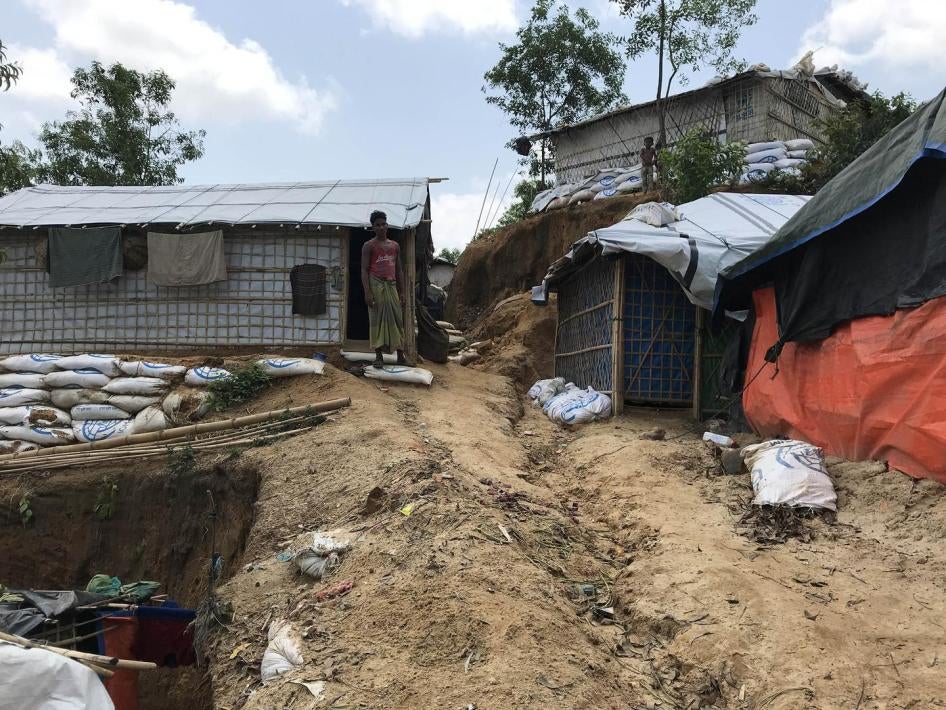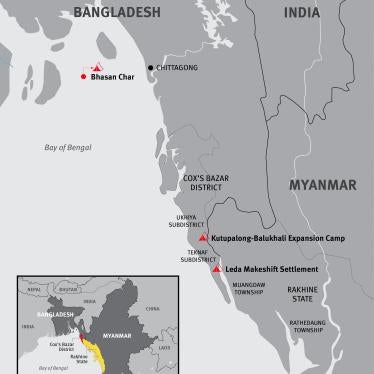Can you describe what you saw at the camp in May?
It was the beginning of the rainy season and it was pretty wet. We were slipping and sliding around, and it was pretty treacherous in places, and I know it’s only gotten worse since then. So many of the huts are built on very steep slopes, on sandy, clay soil. I was looking at a number of people’s houses that I thought were going to get washed away soon. I could not help but think that these people had managed to escape horrifying attacks by Myanmar’s military. But now, their lives were at risk again.
How many refugees are threatened by flooding and landslides?
The United Nations estimates that 215,000 people are at risk of landslides and flooding, and about 44,000 are at very high risk. Camps are supposed to have a density of about 45 square feet per person. This one has an average of 11. It’s very densely packed. I could see places that to me looked like they were at high risk of landslides and flooding. I particularly feared for the vulnerable. These were especially dangerous conditions for older people, children, those living with disabilities. As it turns out I was right to worry. Several children have already been killed in landslides.
In addition to the other dangers that come with people being so packed together – the security risks and fears of disease outbreaks because of contamination and water-borne diseases – the camp was built on an elephant migration route, and some people have been killed by elephants going through the camp. Elephants have not been a huge cause of death, but a lot of people expressed fear of the elephants.
What are the Rohingya doing to prepare?
I was impressed by the refugees’ resilience, and how much people were working to try to improve their conditions themselves. Every time I turned around, I saw someone running with bamboo over their shoulder to shore up their family’s hut. People were working together in a communal way, building hand-railings on steep stairways that are cut into the sides of the hills, because they really are treacherous.
Can you tell us about anyone you met?
I spoke to one girl who was 16 years old. She was completely veiled, I never actually saw her face. She showed me a jar with a bullet that she said was removed from her hip. As she was escaping Myanmar she was shot. She’s disabled and doesn’t have crutches, so she has to walk with the help of her sisters. They’re orphans and they’re living in the camp alone and don’t get any assistance. They asked neighbors to help them build the hut that they’re living in. She told me she would have liked to go to school, but now that seems outside the realm of possibility. She is making the best of her circumstances, but they are very difficult.
What support is the Bangladesh government providing?
The Bangladeshi government insists that the camp is temporary and that the Rohingya refugees will be going back to Myanmar soon. The huts are made of tarp on a frame of bamboo, all held together by twine, and that’s it. And the reason it’s so flimsy is that the government doesn’t want them to build hard shelters or cyclone-resistant shelters because they would have a look of permanence. And the same applies to the schools. They call them “temporary learning centers,” without much of a curriculum, because the Bangladeshi authorities don’t want to give a sense that the refugees will be there for a long time.
What should Bangladesh be doing?
One thing is to move people to safer ground. This is an obvious response from anyone who looks at the mega camp. We understand that there is land near where the mega camp is located, so people would still be close to other refugees. They would also be relatively close to the border with Myanmar, which keeps the hope alive that they will be able to go back to their homes.
The government, on the other hand, says that there is no land to spare. That they have already given up acres and acres of protected forest land to accommodate the refugees. The government has proposed moving significant numbers of refugees to what is effectively a bank of silt, the merely two-decade-old island called Bhasan Char. Moving them will isolate the refugees. It wouldn’t give them a chance to be self-sufficient. It would potentially put them in danger because experts say that if there was a cyclone at high tide, the island could become completely submerged. The refugees have not consented to move there. Chances are, once they are on this island, they would be stuck there and wouldn’t be able to get off.
This plan is really wishful thinking on the part of the Bangladeshi government, that this very large refugee population could be isolated and segregated. I think there is a good chance that refugees would not go voluntarily.
What about moving them to the land close by? Has the government considered this?
This still needs to be explored. And with issuing this report, part of what we’re trying to do is suggest that there may be alternatives to moving them to Bhasan Char. That Plan A isn’t necessarily the best idea, and they ought to consider Plans B and C.
What did the refugees express about what they want?
To a person, every refugee I interviewed said they want to go back to their homes in Myanmar, that they do not want to live in Bangladesh, that they consider themselves nationals of Myanmar. But if they return, they want to be recognized as citizens of Myanmar. They want their Rohingya ethnicity to be recognized, they want freedom of religion, and they of course also want to be able to live in safety, not fear.
The reality is that the Myanmar military ethnically cleansed the Rohingya with a great deal of abuse – including killings, rape, pillage, arson – and on top of that, they have been repressed for generations. The conditions that would make it possible for them to return to their homes in safety and dignity are a long way off. And until those conditions are met, the refugees have nowhere else to go and I think will be staying in Bangladesh for some time to come. The sooner the authorities in Bangladesh recognize that, the sooner the refugees will be able to become self-sustaining, to educate their children, and to provide for themselves.
What role can other countries or international bodies play in addressing this crisis?
International actors need to be united in placing the blame for this situation where it belongs, on the government of Myanmar. This is not a crisis of Bangladesh’s choosing. At a time when many other countries have been pushing refugees away and closing their borders, Bangladesh kept its borders open. For this Bangladesh deserves a great deal of credit. It’s doing what other governments should be doing, of course, as a matter of international law, but Bangladesh deserves a great deal of support by the international community.
Pressure should be put on Myanmar, as we approach August 25, the first anniversary of this crisis, to bring to justice those who committed crimes against humanity against the Rohingya. And concerned governments should press Myanmar to create the conditions – fundamentally changed conditions – that will enable the refugees to return. In the meantime, donors should provide the needed support. The UN appeal for the Rohingya humanitarian crisis for this year is only one-quarter funded. There are great shortfalls in water and sanitation and education, and this is having dire, life-threatening consequences.
Finally, the international community should work with Bangladesh to find sustainable, safer land in proximity to the mega camp in Cox’s Bazar and relocate significant numbers of refugees into smaller camps within that area. If they were moved to Bhasan Char island, as is the current plan, it could become an island prison for them, and that is really untenable.













